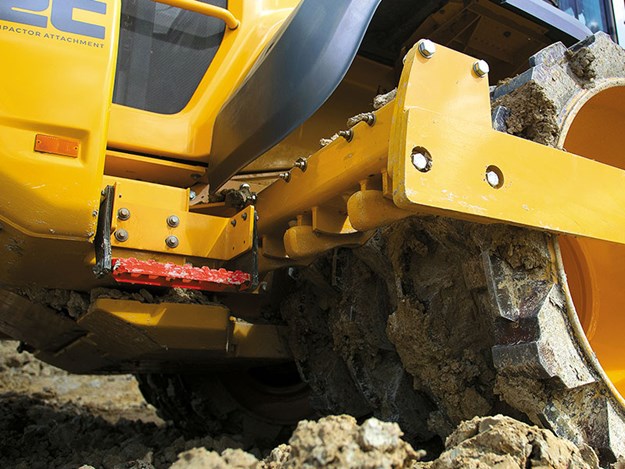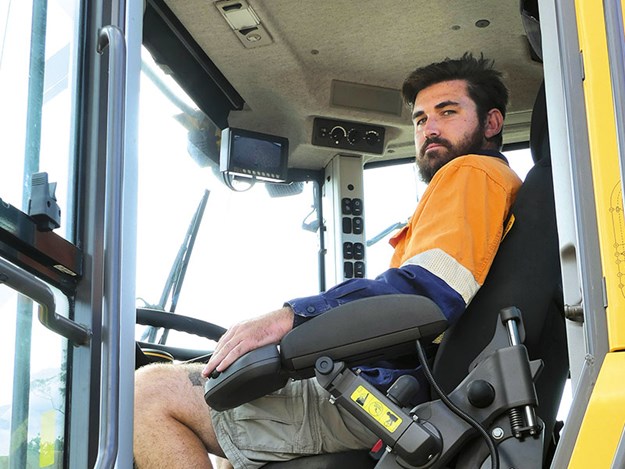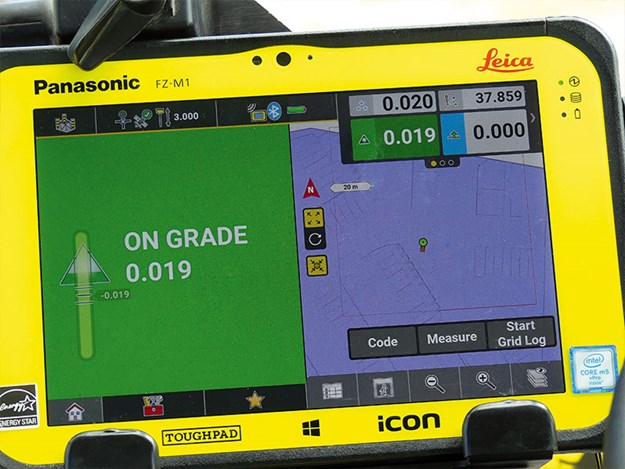Product profile: L2C Compactor Systems
L2C Ltd’s unique bolt-on/bolt-off system easily converts a wheel loader to an earth compactor
Tony says that the issue of having his compactors sitting around for at least half of the year during the winter season and not earning a dollar has led to the L2C Compactor system.
What has evolved over the 20 years-plus development of what Tony calls ‘the ultimate compaction system’ by Allan Cameron (DOW 308) has now become a complete package that can turn a wheel loader into a compactor and vice versa in 24 hours by a mechanical team and a forklift.
The package
 |
|
Tony Wilson
|
The package includes four compactor wheels, a blade, a cleaner-bar system and scraper frames, all chassis fitting plates, manual and installation plans, bolts, plus the 20-feet side-opening container.
While there’s a ‘first time only’ requirement to fit three weld plates to either side of the machine, Tony used the expert services of Hiway Engineering in Silverdale; their certified staff undertook the swapping in a timely and professional manner. This, in turn, allows transformation between loader and compactor simply a matter of bolt-on/bolt-off.
Because all the componentry comes strapped-down in a shipping container, attachments currently not in use can be placed back in the container for safe storage ready for swap-over when the next season comes around.
Being containerised, transportation from one construction site to another is simplified regardless of whether the site is across town, at the other end of the country, or even in another country.
 |
|
The L2C package allows a wheel loader to be swapped to a wheel compactor during earthworks season
|
Tony says the beauty of the system is that the compacting gear doesn’t necessarily have to go onto a new machine; in fact, he says it’s a perfect way to gain some extra years of usage out of an older machine. Convert the old loader into a useful compactor, he says.
To prove the viability of this option, his own company recently fitted the compacting components to a Volvo L180G machine with 16,000 hours on the clock and has saved the company a considerable amount of money by not having to purchase a completely new machine for the job.
The latest set-up
 |
|
Blades on the wheels cut the dirt clods
|
Tony says the latest set-up is what he calls his ‘Series 1’ conversion that’s attached to a new Volvo L120H Optishift wheel loader, which, in standard spec, weighs in at around 22 tonnes but will become a 26-tonne machine when fitted out with the L2C kit.
As the 3.7-metre-wide L2C blade is lighter than the standard bucket supplied with the machine, two bolted hatches are located on the top side of the blade to allow ballast to be added in order to counterbalance the 3.5-tonne rear counterweight, thus providing even weight distribution to all four compactor wheels, optimising overall compaction.
The Series 1 feet and cutters on the 1.1-metre-wide rear compactor wheels are designed in such a way as to track in the empty rows of the front wheels, which are approximately 750mm wide, allowing for maximum coverage as the machine traverses the site, either travelling forwards or backwards.
A Series 2 version fitted to a 25-tonne Volvo L150H will be coming on stream in the next few weeks. This unit will be approximately 30 tonnes and with a wider compaction footprint. Another two units are scheduled to follow soon after.
Smooth ride
 |
|
The foldaway scraper tines create less drag
|
A clever bit of engineering design, whereby cutters that are designed to break up solid clods of clay precede the compactor feet and sit on the drum diameter, providing an exceptionally smooth ride but doesn’t compromise compaction.
This is a feature that certainly wasn’t lost on Xavier Blakeman who was operating the machine on the day of our visit.
Xavier says that not only was the ride smoother than with other compactors he’d operated, but the combination of the L2C package and the Volvo also made for a stress-free day’s work at ‘the office’.
Commenting on the unique design of the compactor wheels, Tony explains that aside from creating a smooth ride, the feature produced a most interesting by-product. He found that because less drag was being created, he was saving a small fortune by using a lot less fuel.
When combined with the efficiency of the Volvo 120H, he was using currently about 15 litres of diesel per hour, a saving of around $600 a day.
Scraper tines
 |
|
Xavier Blakeman
|
Unique-designed counterweighted scraper tines are connected to a cleaner frame, which are fitted to all four wheels, ensuring that the feet are kept from clogging even when compacting wet substrate.
Simplicity is key in the operation of the scrapers, as counterweight allows gravity to dictate the direction of the leading edge, thus eliminating the drag on the drums; less drag means less fuel burn.
Compaction in action
 |
|
Ballast gets added to the blade to provide even weight distribution
|
Adding to the list of in-cab accessories is the on-board GPS machine control system, which not only shows the operator the exact spot on the site requiring compacting but also displays a traffic light system: red is low compaction, orange is nearly compacted, and green for compaction complete.
The DOW team had a first-hand opportunity to witness two 30-tonne dump trucks dropping a load each of clean fill, ready for the Volvo L120H/L2C combination to demonstrate its spreading and compacting capabilities.
As Tony had promised us, the machine effortlessly spread and compacted the piles of fill to a compaction rate, which exceeded specifications in four passes or approximately five to seven minutes on the ground.
However, it has to be borne in mind that this experiment was carried out with a brand-new Volvo L120H Optishift, which would naturally be quite a bit quicker than if the compacting equipment was fitted to an older or less powerful machine.
On subsequent runs, the two 30-tonne dumpers weren’t able to keep the compactor supplied with enough fill, even though they were carting from a stockpile only 150 metres away.
Shear vane test
 |
|
GPS machine control helps achieve faster compaction times
|
Following the first three passes, Tony conducted a shear vane test, which produced some results that were impressive in anybody’s language.
While the specified requirements were a compaction rate of 140kpa, the needle went off the scale, producing 200kpa plus.
That figure obviously had to be verified by Geotech engineers at a later date, but it would be a fairly safe bet to say that a 60kpa-plus margin would gain a pass from the tester.
Tony says that L2C has potential orders to supply six units to customers for next season, with there being from a customer in Australia interested in two units.
Nigel Davies, business development manager for TransDiesel, the New Zealand Volvo agents, was obviously impressed with the L2C conversion.
"I had a look at the machine operating and was impressed with the performance. The L2C conversion kit is so well-engineered you would be forgiven for thinking it’s ex-factory."
High praise indeed for a piece of good old Kiwi know-how.
For more information, contact sales@L2C.co.nz or Tony Wilson 021 923 182.
Find new and used heavy machinery for sale in NZ
Keep up to date in the industry by signing up to Deals on Wheels' free newsletter or liking us on Facebook.

.jpg)
.jpg)
.jpg)
.jpg)
.jpg)

